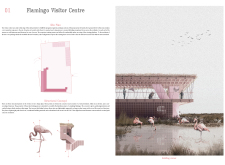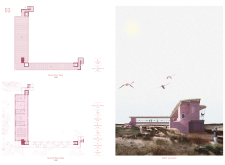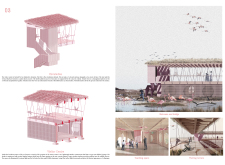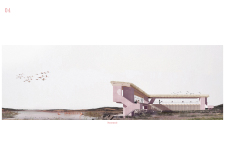5 key facts about this project
Architecturally, the centre adopts an L-shaped layout which not only maximizes the potential for panoramic views of the wetlands but also encourages fluid movement within the space. This shape facilitates a seamless connection between various programmatic functions, including exhibition spaces, educational areas, and visitor amenities. The arrangement allows each section to benefit from natural light while framing the surrounding landscape, creating a dynamic dialogue between built form and environmental context.
Unique design approaches are evident throughout the project, particularly in the use of materials that convey both sustainability and aesthetic warmth. The predominant use of concrete establishes a robust structural presence, while soft wooden trusses add an inviting character to the interior spaces. The incorporation of palm frond roofing not only aligns with local building traditions but also enhances the project’s ecological credentials by utilizing readily available, renewable resources. This careful selection of materials reflects a broader understanding of the importance of integrating local culture and sustainability into architectural design.
One of the most notable features of the Flamingo Visitor Centre is its emphasis on educational engagement. Dedicated learning areas are designed to host workshops and interactive exhibits, fostering a deeper understanding of the ecological significance of the surrounding wetlands. Additionally, strategically placed viewing terraces offer visitors unobstructed sightlines to observe wildlife, thereby enriching the visitor experience and encouraging a connection with nature. The architecture itself acts as a tool for education, with infographics and displays integrated into circulation spaces, enhancing the narrative of the visitor’s journey.
The building also incorporates circulation strategies that promote accessibility and ease of movement. An enclosed staircase and a two-story elevator create a sense of verticality, while allowing visitors to navigate the structure comfortably. These elements are intertwined with informational displays, creating an educational pathway that seamlessly guides guests through the centre. The design prioritizes not only the physical experience of the space but also the cognitive engagement with environmental conservation messages that are critical to the centre’s mission.
In assessing the overall impact of the Flamingo Visitor Centre, it becomes evident that it embodies a design philosophy rooted in environmental sensitivity and education. The project stands as an architectural reflection of its ecological context, combining aesthetic appeal with educational purpose. By appealing to visitors through its thoughtful layout, materiality, and interactive elements, the centre aims to inspire a deeper appreciation for the natural world.
For more information on the Flamingo Visitor Centre, including architectural plans and detailed sections that further illustrate the design and functional aspects, readers are encouraged to explore the project presentation. Engaging with these elements provides a deeper understanding of the architectural ideas that shape this distinctive project.


























